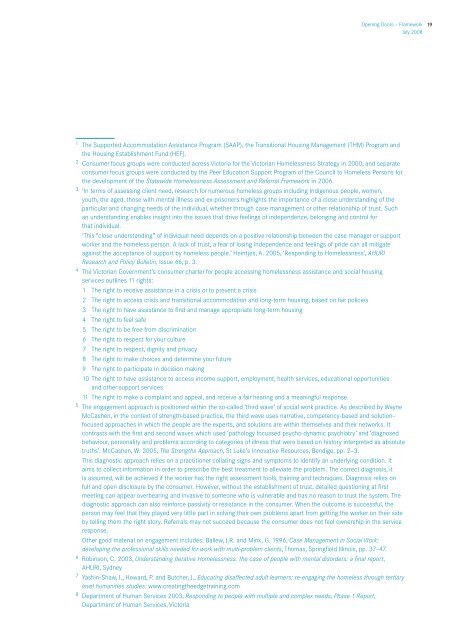Opening Doors – Framework - ACSO
Opening Doors – Framework - ACSO
Opening Doors – Framework - ACSO
Create successful ePaper yourself
Turn your PDF publications into a flip-book with our unique Google optimized e-Paper software.
<strong>Opening</strong> <strong>Doors</strong> <strong>–</strong> <strong>Framework</strong><br />
July 2008<br />
1 The Supported Accommodation Assistance Program (SAAP), the Transitional Housing Management (THM) Program and<br />
the Housing Establishment Fund (HEF).<br />
2 Consumer focus groups were conducted across Victoria for the Victorian Homelessness Strategy in 2000, and separate<br />
consumer focus groups were conducted by the Peer Education Support Program of the Council to Homeless Persons for<br />
the development of the Statewide Homelessness Assessment and Referral <strong>Framework</strong> in 2006.<br />
3 ‘In terms of assessing client need, research for numerous homeless groups including Indigenous people, women,<br />
youth, the aged, those with mental illness and ex-prisoners highlights the importance of a close understanding of the<br />
particular and changing needs of the individual, whether through case management or other relationship of trust. Such<br />
an understanding enables insight into the issues that drive feelings of independence, belonging and control for<br />
that individual.<br />
‘This “close understanding” of individual need depends on a positive relationship between the case manager or support<br />
worker and the homeless person. A lack of trust, a fear of losing independence and feelings of pride can all mitigate<br />
against the acceptance of support by homeless people.’ Heintjes, A. 2005, ‘Responding to Homelessness’, AHURI<br />
Research and Policy Bulletin, Issue 66, p. 3.<br />
4 The Victorian Government’s consumer charter for people accessing homelessness assistance and social housing<br />
services outlines 11 rights:<br />
1 The right to receive assistance in a crisis or to prevent a crisis<br />
2 The right to access crisis and transitional accommodation and long-term housing, based on fair policies<br />
3 The right to have assistance to find and manage appropriate long-term housing<br />
4 The right to feel safe<br />
5 The right to be free from discrimination<br />
6 The right to respect for your culture<br />
7 The right to respect, dignity and privacy<br />
8 The right to make choices and determine your future<br />
9 The right to participate in decision making<br />
10 The right to have assistance to access income support, employment, health services, educational opportunities<br />
and other support services<br />
11 The right to make a complaint and appeal, and receive a fair hearing and a meaningful response.<br />
5 The engagement approach is positioned within the so-called ‘third wave’ of social work practice. As described by Wayne<br />
McCashen, in the context of strength-based practice, the third wave uses narrative, competency-based and solutionfocused<br />
approaches in which the people are the experts, and solutions are within themselves and their networks. It<br />
contrasts with the first and second waves which used ‘pathology focussed psycho-dynamic psychiatry’ and ‘diagnosed<br />
behaviour, personality and problems according to categories of illness that were based on history interpreted as absolute<br />
truths’. McCashen, W. 2005, The Strengths Approach, St Luke’s Innovative Resources, Bendigo, pp. 2<strong>–</strong>3.<br />
This diagnostic approach relies on a practitioner collating signs and symptoms to identify an underlying condition. It<br />
aims to collect information in order to prescribe the best treatment to alleviate the problem. The correct diagnosis, it<br />
is assumed, will be achieved if the worker has the right assessment tools, training and techniques. Diagnosis relies on<br />
full and open disclosure by the consumer. However, without the establishment of trust, detailed questioning at first<br />
meeting can appear overbearing and invasive to someone who is vulnerable and has no reason to trust the system. The<br />
diagnostic approach can also reinforce passivity or resistance in the consumer. When the outcome is successful, the<br />
person may feel that they played very little part in solving their own problems apart from getting the worker on their side<br />
by telling them the right story. Referrals may not succeed because the consumer does not feel ownership in the service<br />
response.<br />
Other good material on engagement includes: Ballew, J.R. and Mink, G. 1996, Case Management in Social Work:<br />
developing the professional skills needed for work with multi-problem clients, Thomas, Springfield Illinois, pp. 37<strong>–</strong>47.<br />
6 Robinson, C. 2003, Understanding Iterative Homelessness: the case of people with mental disorders: a final report,<br />
AHURI, Sydney<br />
7 Yashin-Shaw, I., Howard, P. and Butcher, J., Educating disaffected adult learners: re-engaging the homeless through tertiary<br />
level humanities studies: www.creatingtheedgetraining.com<br />
8 Department of Human Services 2003, Responding to people with multiple and complex needs, Phase 1 Report,<br />
Department of Human Services, Victoria<br />
19


